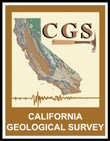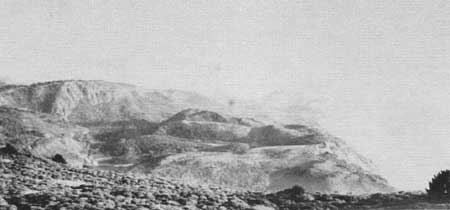
|
California Division of Mines and Geology
Bulletin 202 Geology of the Point Reyes Peninsula, Marin County, California |
GEOMORPHOLOGY
Geomorphology is the study of the shape of the land and how these shapes were formed. The general geomorphology of the area has been discussed under "Geography". Some of the interesting land forms on the peninsula are discussed below.
Fault Zone
The San Andreas fault zone is the dominating geomorphic feature of the area and has been described in the section on the San Andreas fault. Land forms typical of faulting occur all along the fault zone and these are described graphically by Lawson and others (1908, p. 29-35), with many illustrative photographs. It should be emphasized that State Highway 1 between Bolinas Lagoon and Tomales Bay is a display-case of classic fault landforms which can be easily seen from the highway.
Older Topography
Many of the upper slopes of Inverness Ridge show deeply weathered, mature rounded forms quite different from the sharp angular slopes being cut by present streams. The formation of these rounded, mature land forms dates from some earlier, more advanced cycle of erosion than the present one.
Marine Erosion
Like any tectonically active area with a long coast line, the Point Reyes Peninsula displays some dramatic examples of marine erosion. The cliffs along the sheltered waters of Tomales Bay are well protected; but, on the west side of Tomales Point and on the south facing Point Reyes promontory, stacks, rocks, and off-shore islands bear witness to the erosive power of the Pacific Ocean. Between the two points lies the long straight Point Reyes Beach, where erosion and deposition seem to be more or less in equilibrium (Cherry, 1964).
In Drakes Bay the presence of high cliffs points to the existence of substantial erosion; these cliffs are protected from the prevailing northwest wind but receive the brunt of the winter storms, characterized by gales from the south. On several headlands in Drakes Bay, a topographic high is found at or close to the coastline, indicating considerable wave erosion in the past. For instance, the southern extremity of Drakes Head (147 feet elevation) marks the mature stage of a shoreline of submergence, the cliff having been cut back as far as the landward-sloping side of a hill. The drowned valleys of Drakes Estero and Estero de Limantour are evidence that the coast has been submerged.
The eastern part of Drakes Bay is protected by a long sandspit, Limantour Spit. East and south of this area the hard, brittle Monterey shales and cherts have been greatly eroded, particularly where layers and pod-like injections of sand form relatively weak areas which the waves quickly turn into caves. The low terrace covered with land-laid deposits (elevation about 100 feet), which forms such a striking feature of the coast here, must have originally extended much farther seaward.
South of Bear Valley the terrace disappears completely and a large area of landsliding persists for several miles southward to the vicinity of Palomarin Ranch. While earthquakes and faults have probably contributed to the formation of this large complex of landslides, one of the immediate causes is the erosion of the incoherent sea cliff, which results in continuation of the sliding. Gilbert (1908) observed a change in the landslide area after the 1906 earthquake.
South of Palomarin Ranch, the amount of erosion was accurately measured by the U.S. Coast and Geodetic Survey. Since 1859 Duxbury Point has eroded about 60 meters, Bolinas Point has eroded about 50 meters, and a point 4000 feet north of Bolinas Point has eroded about 60 meters. These measurements indicate an average rate of erosion of around 2-1/2 feet per year. Along this stretch of coast from Palomarin Ranch to Duxbury Point, the Monterey mudstones are well bedded and mostly dip at about 45 degrees seaward. Thus, when the bedding planes are lubricated with rainwater or drainage water, landslides are very apt to occur at the sea cliff. Waves quickly remove the material at beach level and the whole slide remains unstable, gradually eroding back from the ocean in an effort to reach a stable angle of repose.
At Bolinas, soft sands and silts of the cliffs in the Merced Formation are sheltered from the prevailing northwest winds but face the southerly storms of winter. Here erosion has also been dramatic. A house originally built on the ocean bluff (along with its site) has entirely disappeared, while another projects over the cliff and is supported by pillars. A bulkhead, built in the 1890s at the base of the cliff, was destroyed about 1913 by winter storms. From the bulkhead remains, it was determined in 1962 that the cliff has eroded about 75 feet since 1913, an average of 1-1/2 feet per year. Erosion here, as elsewhere in the Point Reyes Peninsula, is irregular and several years often pass without any obvious recession of the cliff.
Bolinas Lagoon and Tomales Bay
These two bodies of water have the appearance of drowned valleys, and both are in the San Andreas fault zone. They occupy valleys that must have been eroded during a low stand of the sea, perhaps at the time of the Wisconsin glaciation (figure 4), after which the return of the sea to its present level flooded the parts adjacent to the ocean (photo 1). Both inlets are at present being silted up by erosional debris from the surrounding hills. The present-day streams, rejuvenated by the earlier retreat of the sea, have cut sharp V-shaped canyons in their lower courses; the effect of this can be seen in Bolinas Lagoon where Pine Gulch Creek is building a delta into the Lagoon (see "Stream Diversion").

|
| Figure 4. Variations of sea level during the Ice Age. From Fairbridge, 1960; reprinted with permission from 'Scientific American'. (click on image for a PDF version) |
Alluviated Valleys
The long, narrow alluviated valleys of Laguna Ranch Creek, Muddy Hollow Creek, and Glenbrook Creek were originally V-shaped. The coastal outlets of these creeks have been affected by the downwarping of the Point Reyes syncline. Marshes, lagoons, and sandspits have been formed and the valleys have been partly filled with alluvium. The upper reaches of the creek valleys are steep-sided and the canyons would be distinctly V-shaped if the alluvium were removed. The alluviation of these valleys, therefore, is later than a period of vigorous erosion which cut the original V-shaped valleys (photo 28). The cutting of the valleys took place during a period of low sea level, probably during the Wisconsin glacial period; the alluviation of the valleys took place later, when the Point Reyes syncline was formed and the valleys were invaded (drowned) at their lower ends by the sea.

|
| Photo 28. View south with Drakes Bay and Limantour Spit in the background. The long, narrow alluviated valleys of Muddy Hollow Creek (right center) and Laguna Ranch Creek (left) lie east of Drakes Estero. Photo courtesy of Aero Photographers, Sausalito. |
Point Reyes Promontory
The area between the granitic promontory of Point Reyes and Drakes Estero is distinguished by an anomalous alignment of ridges and valleys running approximately northwest-southeast, as compared with the prevailing N.35°W. strike of the San Andreas fault and Inverness Ridge. These ridges and valleys are controlled partly by the structure of the area, the ridges being in most cases the expression of harder layers in the Drakes Bay Formation, which in this area is folded into an anticline and syncline striking northwest-southeast. The valleys are the remains of tributaries to the main stream which occupied Drakes Estero before it was flooded by the sea. At that time, the sea coast must have extended many miles further south, and the river system would have been correspondingly well developed.
Landslides
Evidence of landslides is common in the Coast Ranges. Most of the sea cliff erosion along the coast proceeds by way of local landsliding. In addition an unusually large group of ancient landslides is present along the coastline of Point Reyes Peninsula between Millers Point near the mouth of Bear Valley and Palomarin Ranch. These landslides have been described in detail by Clague (1969). The landslides are the site of the Seven Lakes, after which the Lake Ranch was named. In this dry country underlain by fractured shale, lakes are very unusual. The slide area was noticed by Gilbert (1908) but otherwise has passed formally unrecorded until recently. The northern portion of the landslide area is shown in photo 29.

|
| Photo 29. Area of landslides at Double Point. Photo by J. J. Clague. |
The rocks involved in the landsliding are shale, chert, and sandstone of Miocene and Pliocene age, including the Monterey Shale and Drakes Bay Formation. The landslide area unequivocally extends nearly 5 miles along the coast and about 2 miles inland. Older sliding probably extends an additional mile northward and possibly an additional mile inland.
The slides are recognized by morphological features, such as pressure ridges, steep escarpments, closed depressions, and hummocky ground, and by stratigraphic and structural features including rotated and offset bedding, disrupted strata, clastic injections, and planes of sliding.
The Wildcat, Double Point, and Palomarin slides, termed younger landslides, occurred after the cutting of the Bolinas marine terrace. The older landslides may be older than this terrace and are found inland from the younger landslides. Clague (1969) lists as causal factors:
(1) Local southwest dips in the same direction as the slope of the land.
(2) Removal of the toe of the slides by coastal erosion.
(3) The moderately steep slope of Inverness Ridge.
(4) The high permeability of the jointed shales and cherts and the seasonal precipitation.
(5) The low shearing stress of the rocks involved.
(6) Proximity to the San Andreas fault.
He concluded that the landslides attained their present form by repeated small, earthquake-triggered displacements. The major part of the younger landsliding probably took place within the last 10,000 years.
Another prominent area of landsliding involving the Drakes Bay Formation lies at the southwest end of Drakes Bay beach, exactly on latitude 38° N. The landslide area is semicircular in form with a diameter of about 2000 feet. The landslide occurred where the highest cliff of these soft beds must once have stood. The landslide is being steadily eroded away at sea level by wave action. Its fresh appearance suggests that sliding is still taking place here.
Landsliding also occurs above the sea cliff at Bolinas Point. Here the seaward 45-degree dip of the Monterey Shales and mudstones and the rapid erosion of the sea cliff contribute to the landsliding.
| <<< Previous | <<< Contents >>> | Next >>> |
state/ca/cdmg-bul-202/sec4.htm
Last Updated: 28-Nov-2007